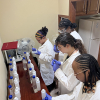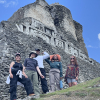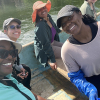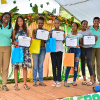BioGals Partners with Belize Community for Sustainability Experience
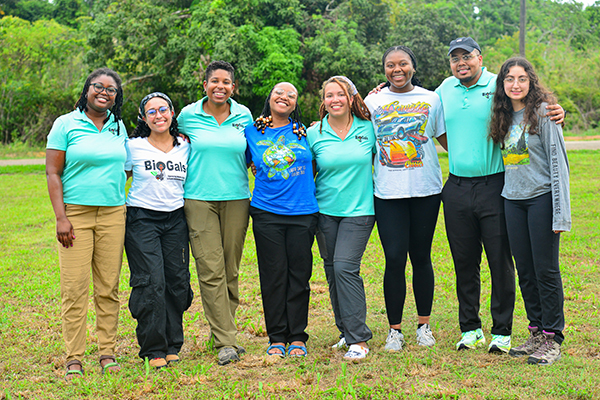
Oct. 10, 2023 - When Shakira Hobbs was an undergraduate at University of Maryland, she spent her spring break in Belize, sloughing through the Sittee River measuring mangroves. That experience, as part of a tropical ecology course, fueled an interest in sustainability and a desire to pursue community-engaged research in engineering. This past summer, as a UCI assistant professor of civil and environmental engineering (CEE), Hobbs led her own group of students back to the small Central American country for a week of field research coordinated through an organization called BioGals.
Hobbs started BioGals in 2015 with her classmate from Arizona State University Evvan Morton, while they were both working on their doctorates. The nonprofit organization seeks to increase the visibility of women of color in STEM who are working to solve complex problems that lead to a more sustainable world. BioGals’ mission aligns well with UCI’s Black Thriving Initiative to advance the understanding of the Black experience and leverage institutional resources to accelerate the change required. BioGals partners with the Sittee River community to determine where their help and expertise are most needed.
Hobbs collaborated with the Belize Department of Environment to design the BioGals 2023 Sustainability Experience focused on water quality testing. Four students participated: Maya El Ajouz, UCI CEE undergraduate; Ashely Green and Alexis Woods, UCI CEE graduate students; and Shamariah Brown, Cincinnati State Technical and Community College undergraduate student in environmental engineering technologies. El Ajouz and Green were supported by scholarships from the Samueli School’s Dean’s Office.
BioGals’ mission during the week was to collect water samples from various sites along four rivers. They then treated and prepared the samples at a Belize Department of Environment lab for transportation back to UCI where the samples are being analyzed for a chemical called glyphosate.
“We are looking for glyphosate, a herbicide commonly used in agriculture and specifically in fields growing sugar cane, the main crop in Belize,” explained El Ajouz, who is interested in water resources. “We spent two days collecting samples and one day in the lab.”
Glyphosate is the active ingredient in weed killers such as Roundup. The chemical can be sprayed directly onto crops without damaging the crops themselves but effectively killing the surrounding weeds.
“It helps with crop production, which is important as human population increases, but it has unintended health impacts,” explained Hobbs. Her team is interested in glyphosate’s potential exposure and impacts to human health and the environment.
Currently, discrepancies exist in risk assessments from the U.S. Environmental Protection Agency, World Health Organization and the International Agency for Research on Cancer regarding the toxicity of glyphosate. The EPA says it is not likely to cause cancer to humans when used according to directions, while the IARC and WHO indicate that it is a probable carcinogen to humans.
Hobbs operates with a belief that we should safeguard human health in the meantime, by being aware of the chemical’s presence and quantities, while the regulators continue to determine what are safe levels of long-term exposure.
“We’re looking to see if glyphosate is present in streams and in what concentrations,” she said. “Certain watersheds have different uses -- fishing, watering crops, drinking. Glyphosate biodegrades relatively quickly but in some situations such as heavy rainfall, water moves too fast and there may not be enough time for it to lose its harmful effects.”
The area they studied in Belize is made up of limestone and features a landscape of sinkholes, underwater caves and springs. This karst topography provides conduits for water to flow through. Hobbs believes that this serves as a natural filter, particularly during low precipitation, for biodegradation of the pollutant to occur.
Before traveling to the country, one of her students used satellite data and geospatial modeling to identify potential hotspots of glyphosate presence in bodies of water near agricultural areas in Belize.
“We input certain parameters and modeled the transport of potential pollutants based on different variables, like seasons, dry or rainy, when the pesticide might be applied, infiltration and so forth,” Hobbs explained.
Hobbs’ lab also developed a pretreatment method, involving a chemical and thermal process, that stabilizes the water samples. The students conducted the process in a lab at the Belize Department of Environment, where they also taught it to their colleagues there.
The Sustainability Experience did not solely focus on research. The students went on several excursions -- snorkeling among coral reefs, cave tubing, visiting Mayan ruins and learning about the culture and history of the Mayan civilization.
Green, who was thankful for the experience and hopes to return, was impressed with the community-based structure of the research. “It’s not about imposing our views on another group but sharing a dialogue and learning with the community about their needs,” she said. “It was cool to see how the water policies and monitoring are formed and conducted in another country.”
Since returning to Irvine, Hobbs and Woods have been running the samples through an expensive high-tech machine to evaluate the chemistry and determine the concentrations of glyphosate. This equipment is not readily available in Belize, so the advanced analysis makes Hobbs a valuable research partner for Belize. She recently published her methods in an American Chemical Society publication.
Woods, who is working toward her master’s degree/doctorate in environmental engineering, will be presenting the data at the Ninth Annual HBCU Climate Change Conference in New Orleans in October. The results will be shared with the Belize research partners and community first.
“Results show that all the sample sites in Belize contained glyphosate and majority water samples were above the WHO limit, which classifies glyphosate as a possible carcinogen to humans. Our lab has detected glyphosate in Kentucky and California with similar concerning results,” explained Hobbs.
In addition to the findings on glyphosate, Woods will share the things they learned regarding the sample pre-treatment and storage methods. “Not all labs have the same resources. That needs to be considered when designing practices, enabling them to be done in a lab anywhere and especially one with limited resources,” she explained.
Woods hopes to eventually work in a national lab or government agency. “I’d like to continue working with water quality and help agencies see that we need to pay more attention to our regulations and provide scientific data to back those claims.”
BioGals has purchased land in the Sittee River community and plans to build a center with lodging so it can continue to take groups of students on sustainability research trips. “UCI attracts students from diverse backgrounds with valuable experiences that can be nurtured and integrated into study abroad experiences like the one BioGals provides,” said Hobbs. “I believe students are looking to take what they learn in the classroom and apply it in a meaningful way, to address global issues like climate change while gaining more insight and empathy about the world. With these experiences, they find a sense of belonging and become more comfortable identifying and practicing as an engineer.”
– Lori Brandt

